What do candidates on the Industrial Electrical Maintenance course actually do?
At the beginning of the course, candidates learn about basic electrical principles. This grounding in the fundamental concepts ensures a full understanding of the technical and safety issues in the later stages of the course.
Candidates learn in a practical way about ohm's law, series and parallel circuits etc, seeing at first hand what the relationships are between voltage, current and resistance. The following are some example of the course notes for this part of the course, describing ohm's law, series and parallel circuits and solenoids, relays and contactors:
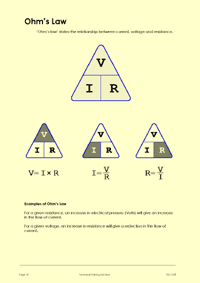 |
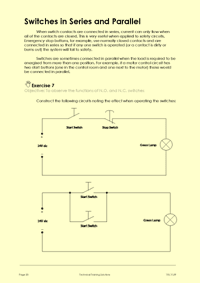 |
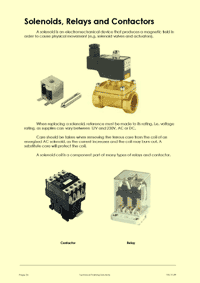 |
Page 12 of Part 1 of the electrical maintenance training course notes, describing ohm's law |
Page 20 of Part 1 of the electrical maintenance training course notes, describing series and parallel circuits |
Page 26 of Part 1 of the electrical maintenance training course notes, describing solenoids and relays |
We ensure that this part of the course is kept interesting and relevant to the objectives of the course by avoiding any unnecessary theory and introducing some commonly-used industrial components, whilst using multimeters to make measurements, exploring the basic electrical principles as they go. To achieve this we have constructed exercise boards with industrial switches, sensors, relays, contactors etc so that they can build circuits, make measurements using digital multimeters, gain familiarity with the components and learn about the principles in a structured, interesting and enjoyable way.
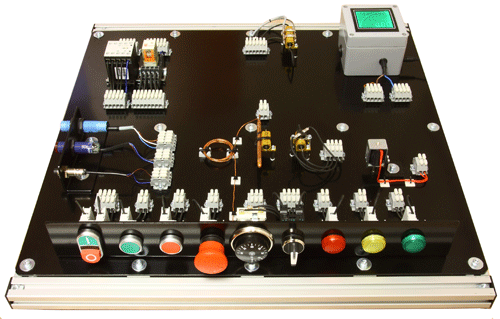 |
Our custom-designed basic circuits rig allows candidates to build basic electrical circuits and learn about electrical principles whilst familiarising themselves with the basic electrical components in week 1 of the electrical maintenance training course |
In the early days of the electrical maintenance skills course candidates also study the common industrial electrical components that they are likely to encounter - proximity detectors, relays, thermocouples, Pt100s and others. More complex circuits incorporating these components are constructed on the basic circuits board shown above. They also have an in-depth briefing of the effects of electric shock - a key issue on this course, as we need to be confident that they are aware of the potential dangers. The following are example pages from this part of the course notes for the electrical maintenance skills course, describing proximity detectors, relays and the effects of electric shock:
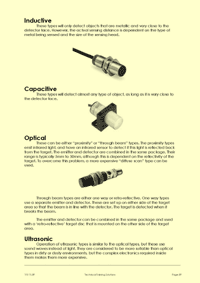 |
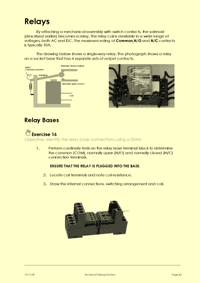 |
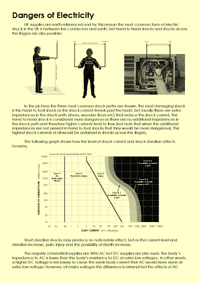 |
Page 39 of part 1 of the electrical maintenance training course notes, describing proximity detectors |
Page 43 of part 1 of the electrical maintenance training course notes, describing relays |
Page 50 of part 1 of the electrical maintenance training course notes, describing the effects of electric shock |
In the next part of the industrial electrical maintenance course the candidates build on the fundamentals by learning about electrical dangers and protection methods; the principles of earthing, how the effects of electric shock are reduced, fuses, circuit breakers, RCDs and other related issues. They also learn about the Electricity at Work (EAW) Regulations and how these might affect their future work - exploring issues like live-working, competency, etc. The following are example pages from this part of the course notes for the industrial electrical maintenance course, describing the various types of fuses available, how insulation resistance testers should be used and how electrical systems should be isolated (getting the candidates to think through the various stages necessary):
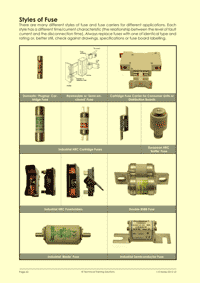 |
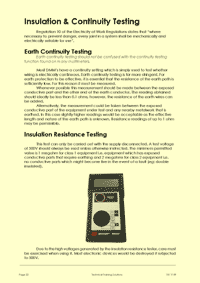 |
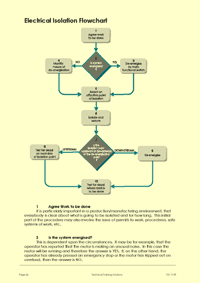 |
Page 62 of the electrical maintenance training course notes, describing the various types of fuses available |
Page 70 of the electrical maintenance training course notes, describing insulation and continuity testing |
Page 76 of the electrical maintenance training course notes, describing isolation procedures |
We explore the skills of fault-finding by discussing the most common fault conditions e.g. open circuit, short circuit and insulation breakdown. The candidates are provided with course notes that explain how these faults can be found in real industrial electrical systems.
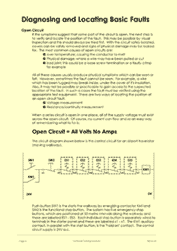 |
 |
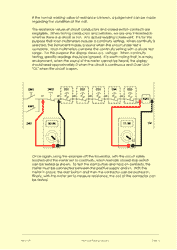 |
Page 80 of the course notes for the electrical fault-finding part of the course |
Page 85 of the course notes for the electrical fault-finding part of the course |
Page 91 of the course notes for the electrical fault-finding part of the course |
The candidates are then given fault simulation rigs and test equipment. The simulation rigs present the candidates with industrial sensors, relays and switches that provide a range of faults and symptoms. In some cases the candidates may not immediately be aware of any faults as the equipment appears to be working correctly. However, by using logical fault-finding methods and the equipment provided, candidates are able to successfully diagnose faults that impact upon safety as well as circuit functionality. The simulated faults range from open-circuits, burned out heaters, welded switch contacts, burnt out relay coils and faulty proximity detectors. All testing is carried out in complete safety because the fault-finding panel's control and load circuits operate at 24V DC and 24V AC.
We also explain the effects of overload, short circuit and earth faults in electrical systems, showing how the various protective devices like fuses, circuit breakers and RCDs operate. We have a specially-constructed demonstration unit for this, so that candidates can explore these important issues.
The following is one of the fault-finding training rigs and the unit used to demonstrate the effects of short circuits, overloads and earth faults.
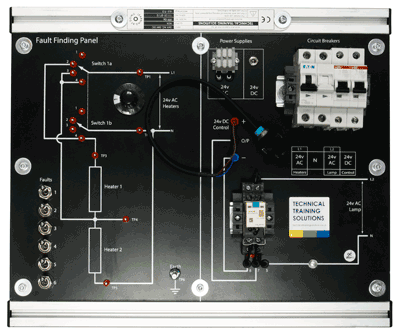 |
 |
The fault-finding test board used on the electrical maintenance training course |
The electrical fault board used on the electrical maintenance training course - this is used to explain what happens when short circuits, earth faults and overloads occur |
We teach the candidates the right way to prepare and terminate cables into plugs and sockets and how to use professional crimp tools to crimp conductors properly.
Candidates also learn why and how insulation and continuity testers are used. We have developed simulation units so that they can test the leads they have manufactured to prove that the continuity and insulation resistance readings are acceptable. We then switch in a range of faults: open circuits, short circuits, polarity reversals and insulation breakdown which they have to find. Below is the rig used for the cable termination exercise, one of the insulation resistance testers used and examples of some of the leads that candidates build on the course:
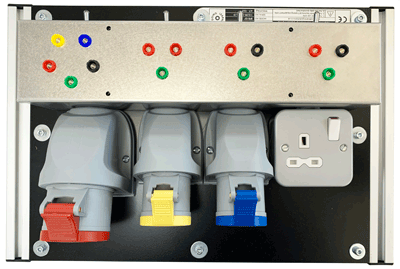 |
 |
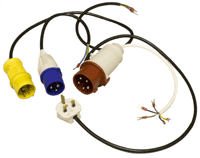 |
This is the cable termination rig used on the electrical maintenance training course. We can switch faults into these that the candidates need to find. |
We use professional insulation resistance / continuity testers on the electrical maintenance training course |
Examples of some of the leads that candidates construct on the electrical maintenance training course |
We then teach the candidates about three-phase motors: how they work, identification features, terminal configuration, testing, etc, whilst using their knowledge of voltage, current and resistance to understand the principles of induction.
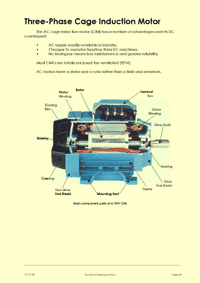 |
 |
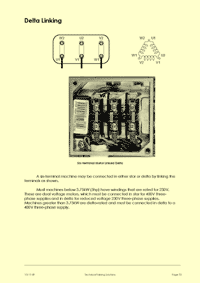 |
Page 5 of part 2 of the electrical maintenance training course notes, describing the key features of cage induction motors |
Page 9 of part 2 of the electrical maintenance training course notes, describing the information found on the nameplates of industrial motors |
Page 13 of part 2 of the electrical maintenance training course notes, describing the configuration of the terminals of a delta-linked motor |
Having learned how three phase motors work, how they're wired and what might go wrong with them, we now look at the common faults that motors experience. Our motor fault simulator is used to show the candidates the most common faults. In position 1 of the selector switch we get the readings that a healthy motor would exhibit but in the other positions we get various faults that the candidates need to discover. We use a continuity and insulation resistance tester to find these faults. The faults that we simulate are open circuit windings, shorted turns and insulation breakdown. The candidates have to use the insulation resistance tester set to 500V to actually find the insulation faults because a normal multimeter won't expose them. |
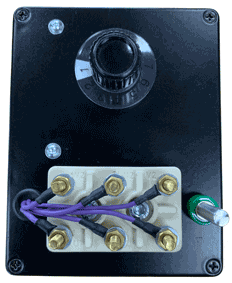 |
 |
The motor fault simulator |
The readings from the simulator |
Next we explain the various standards of symbols used on industrial circuit diagrams and look at the function of the most common components found in control panels - contactors, overload relays, etc. The following are example pages from this part of the electrical maintenance skills course, describing electrical symbols, contactors and overload relays:
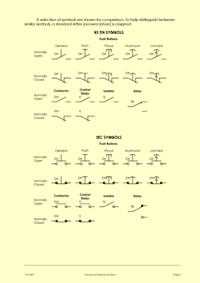 |
 |
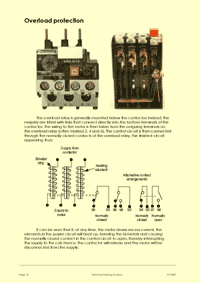 |
Page 17 of part 2 of the course notes for the electrical maintenance training course, describing the various electrical symbols used on drawings for a range of common Standards |
Page 20 of part 2 of the course notes for the electrical maintenance training course, describing how contactors are used |
Page 23 of part 2 of the course notes for the electrical maintenance training course, describing how overload relays are used |
We then introduce industrial control panels with DIN-rail mounted components like circuit breakers, fuses, contactors, overload relays, timers, switches and lamps. The candidates build some basic industrial electrical circuits - for example from simple DOL to star/delta motor starters - giving them the experience of recognising each of the components, their markings and terminal identifications, the differences between the load and control circuits etc, in an engaging way that they really enjoy. The following are the three-phase 40V motors we use, the empty control panel (before candidates have assembled their circuits) and the components that they use to build the circuits:
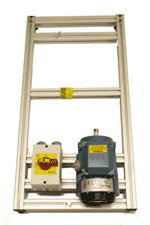 |
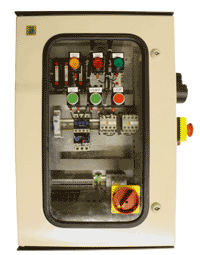 |
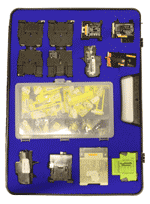 |
This is one of the specially-wound 40 volt three-phase motors used on the electrical maintenance training course |
We have designed a special training rig so that the candidates actually build the circuits that we give them, using real industrial components, following the circuit diagrams provided in the electrical maintenance training course |
Candidates are provided with a range of industrial circuit breakers, contactors, timers and overload relays with which to build the circuits that we give them on the electrical maintenance training course |
Reading circuit diagrams and translating them to real components is a key objective of the course. The best method for learning about this is to engage the candidates in an enjoyable way and therefore we provide the candidates with (amongst others) the following example circuits which they build into the panels shown above:
 |
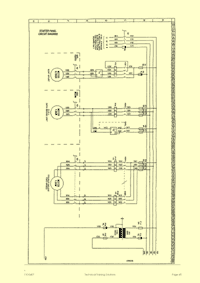 |
 |
Page 41 of part 2 of the course notes for the electrical maintenance training course, describing how DOL starters work - candidates build this circuit in the panels shown above |
Page 45 of part 2 of the course notes for the electrical maintenance training course, describing star/delta starters - candidates build this circuit in the panels shown above |
Page 46 of part 2 of the course notes for the electrical maintenance training course, describing a complex control circuit diagram - candidates build this circuit in the panels shown above |
The candidates can then (before connecting these circuits to our custom-manufactured 3-phase 40 Volt motors) inspect and test their prepared units, ensuring that the circuits have been interpreted correctly. We have developed a three phase 40 Volt AC supply to power these systems so that all this can be done safely. The following are examples of our 40 Volt three-phase supply units, one of the control panels assembled and ready for the candidates to wire up, and our testing for dead instruments:
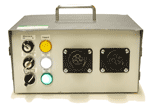 |
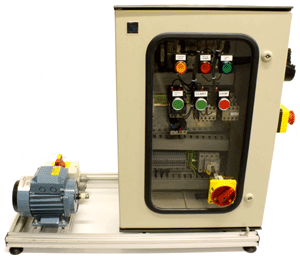 |
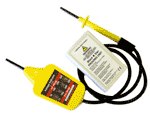 |
This is our specially-designed three-phase 40 Volt ac supply: It generates its output from a single-phase mains supply, so that we can provide the course without needing a three-phase supply for the electrical maintenance training course |
One of the control panels, ready for wiring by the candidates on the electrical maintenance training course |
Candidates use professional voltage testers and proving units on the electrical maintenance training course |
The above units can then be powered-up to check for their correct functionality. Any faults need to be rectified and candidates gain valuable experience of faultfinding in real industrial control panels during this exercise.
Once the systems are working correctly we can then explore various scenarios in which candidates work out how a safe isolation should be performed on their systems. We can simulate a variety of scenarios, including situations in which the system has local and remote start/stop and local and remote isolators. Candidates give their written explanation (a method statement of work) for how they intend to do this and once they have written it correctly we ask them to perform it for real on the systems that they constructed earlier.
The above exercise is one of the focal points of the course as it brings together not only the candidate's ability to perform an electrical isolation but also their use of voltage testers, recognition of the various components, an understanding of the system etc.
We then replace some of the components in the candidates' functional systems with faulty components like burned out contactors, faulty overload relays, incorrect contactor coil voltages, faulty auxiliary contacts etc. Candidates then fault-find the systems to diagnose the faults.
To be absolutely sure that the candidates have understood the key teaching points of the course we then administer a multiple choice assessment paper.
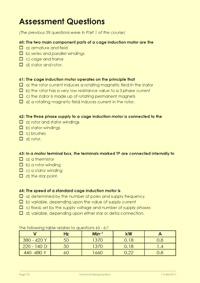 |
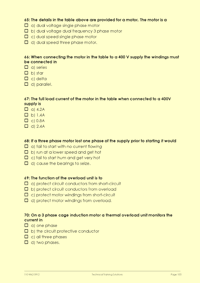 |
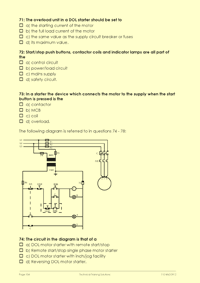 |
Part of the Assessment Paper for the Industrial Electrical Maintenance Course |
||
If you would like to see some of the equipment used on the industrial electrical maintenance course for yourself, then please call us to arrange a visit to our offices in Kent. Alternatively, we can visit you anywhere in the British Isles.


